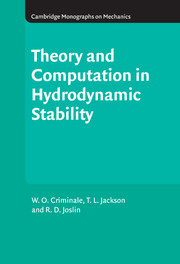Book contents
- Frontmatter
- Contents
- Figures
- Tables
- Preface
- 1 Introduction and problem formulation
- 2 Temporal stability of inviscid incompressible flows
- 3 Temporal stability of viscous incompressible flows
- 4 Spatial stability of incompressible flows
- 5 Stability of compressible flows
- 6 Centrifugal stability
- 7 Geophysical flow
- 8 Transient dynamics
- 9 Nonlinear stability
- 10 Transition and receptivity
- 11 Direct numerical simulation
- 12 Flow control and optimization
- 13 Investigating hydrodynamic instabilities with experiments
- References
- Author index
- General index
7 - Geophysical flow
Published online by Cambridge University Press: 06 July 2010
- Frontmatter
- Contents
- Figures
- Tables
- Preface
- 1 Introduction and problem formulation
- 2 Temporal stability of inviscid incompressible flows
- 3 Temporal stability of viscous incompressible flows
- 4 Spatial stability of incompressible flows
- 5 Stability of compressible flows
- 6 Centrifugal stability
- 7 Geophysical flow
- 8 Transient dynamics
- 9 Nonlinear stability
- 10 Transition and receptivity
- 11 Direct numerical simulation
- 12 Flow control and optimization
- 13 Investigating hydrodynamic instabilities with experiments
- References
- Author index
- General index
Summary
General properties
From the class of flows that are termed geophysical, there are three that are distinct and these more than illustrate the salient properties that such flows possess when viewed from the basis of perturbations. First, there is stratified flow. In this case there is a mean density variation and it plays a dominant role in the physics because there is a body force due to gravity. At the same time, the fluid velocity, to a large degree of approximation, remains solenoidal and therefore the motion is incompressible. The net result leads to the production of anisotropic waves, known as internal gravity waves, and such motions exist in both the atmosphere and the ocean.
Second, because of the spatial scales involved, motion at many locations of the earth, such as the northern or southern latitudes, are present in an environment where the effects of the earth's rotation cannot be taken as constant. On the contrary, rotation plays a dominant role. Again, this combination of circumstances leads to the generation of waves.
Viscous effects can be neglected in the analysis for both the stratified flow and the problem with rotation but the presence of a mean shear in either flow – as we have already seen so often – does lead to important consequences for the dynamics when determining the stability of the system.
Third, there is the modeled geophysical boundary layer where the rotation is present but taken as constant and the surface is flat.
- Type
- Chapter
- Information
- Theory and Computation of Hydrodynamic Stability , pp. 196 - 228Publisher: Cambridge University PressPrint publication year: 2003

